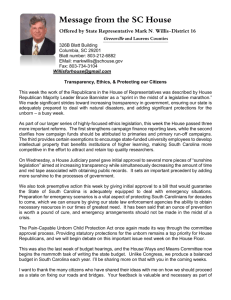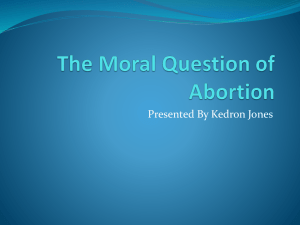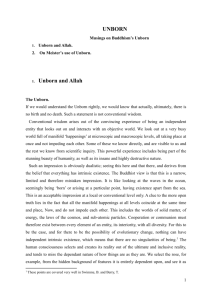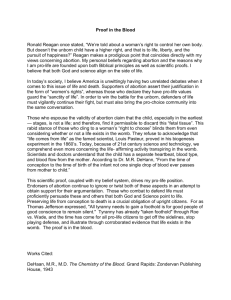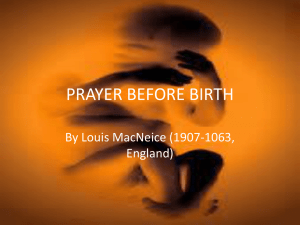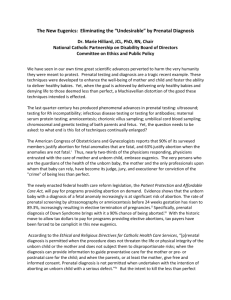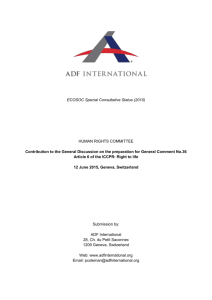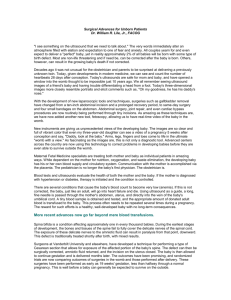The American Center Law Justice - Office of the High Commissioner
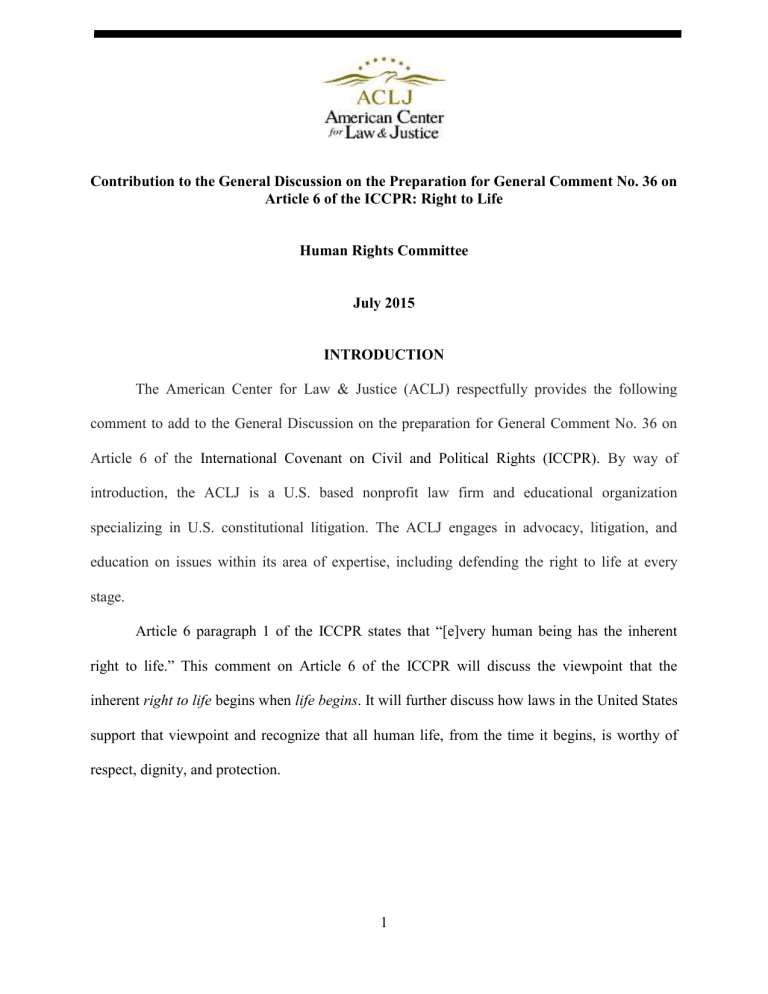
Contribution to the General Discussion on the Preparation for General Comment No. 36 on
Article 6 of the ICCPR: Right to Life
Human Rights Committee
July 2015
INTRODUCTION
The American Center for Law & Justice (ACLJ) respectfully provides the following comment to add to the General Discussion on the preparation for General Comment No. 36 on
Article 6 of the International Covenant on Civil and Political Rights (ICCPR). By way of introduction, the ACLJ is a U.S. based nonprofit law firm and educational organization specializing in U.S. constitutional litigation. The ACLJ engages in advocacy, litigation, and education on issues within its area of expertise, including defending the right to life at every stage.
Article 6 paragraph 1 of the ICCPR states that “[e]very human being has the inherent right to life.” This comment on Article 6 of the ICCPR will discuss the viewpoint that the inherent right to life begins when life begins . It will further discuss how laws in the United States support that viewpoint and recognize that all human life, from the time it begins, is worthy of respect, dignity, and protection.
1
DISCUSSION
I.
When Life Begins
The majority position in the scientific community is that conception—life—occurs at the moment of fertilization.
1
Fertilization occurs when the sperm and egg combine.
2
Most scientists agree that when a sperm and egg combine, a new, distinct human being is formed.
3 That new human being then continues to grow and demonstrates independence early on in the womb by responding to internal and external stimuli.
4
Upon fertilization, the independent “gamete” existence of the sperm and egg is terminated, and a zygote is formed; a new and distinct human being.
5
The zygote is considered a
“fully complete (albeit immature) human organism; it is an ‘individual constituted to carry on the activities of life by means of organs separate in function but mutually dependent: a living being.’”
6
This objective and scientifically based observation leads scientists to conclude “that human embryos, from the zygote stage forward are indeed individuals of the human species— human beings.” 7
The zygote is considered “alive.”
8
The United States government agrees with the majority position that life begins at fertilization. According to the U.S. Department of Health and Human Services, fertilization is
1 Maureen Condic, When Does Human Life Begin? A Scientific Perspective , T HE W ESTCHESTER I NSTITUTE 5 (Oct.
2008), http://bdfund.org/wordpress/wp-content/uploads/2012/06/wi_whitepaper_life_print.pdf.
2 Id.
3 See Phillip G. Peters, Jr., The Ambiguous Meaning of Human Conception , 44 U.C.
D AVIS L.
R EV . 203 (2006).
4 See M. Zimmermann, Pain in the Fetus: Neurobiological, Psychophysiological, and Behavioral Aspects , NCBI
(Sept. 5, 1991), http://www.ncbi.nlm.nih.gov/pubmed/18415186.
5 Condic, supra note 2.
6 Id.
at 7.
7 Id.
at 12.
8 Steven Benner, Defining Life , A STROBIOLOGY (Dec. 10, 2010), http:// www.ncbi.nlm.nih.gov/ pmc/ articles/PMC3005285/.
2
“the process of union of two gametes whereby the somatic chromosome number is restored and the development of a new individual is initiated.”
9
II. United States Law
In the United States, both state and federal laws exist that explicitly and implicitly treat unborn children as persons from the moment of conception.
10 These laws recognize that at the moment a life begins, it is worthy of respect and protection under the law.
11
In fact, the Supreme
Court of the United States, in upholding the Federal Partial-Birth Abortion Ban Act of 2003, stated that “[t]he government may use its voice and its regulatory authority to show its profound respect for the life within the woman.” 12
The Court went even further by explaining that the state has an “interest in promoting respect for human life at all stages in the pregnancy .” 13 Thus, the government’s interest in protecting the unborn exists as soon as life exists.
In light of the U.S. Department of Health and Human Services definition, and the
Supreme Court’s position that the state has a strong interest in protecting the lives of the unborn at all stages, federal and state enacted laws treat unborn children as persons from the moment of conception. For example, researchers in fertility and embryology laboratories are unable to receive federal grants if their research involves the destruction of early embryos.
14
Federal funding for stem cell research is also unavailable if it is derived from destroyed post-conception embryos.
15
Not only does the federal government have a strong interest in protecting the lives of the unborn, but so do the states. For instance, the Supreme Court of Alabama noted that “unborn
9 Fertilization , M EDLINE P LUS M EDICAL D ICTIONARY , http://www.merriam-webster.com/medlineplus/fertilization
(last visited June 10, 2015) (emphasis added).
10 Peters supra note 3, at 200.
11 Id. at 201.
12 Gonzales v. Carhart, 550 U.S. 124, 157 (2007).
13 Id. at 163.
14 Peters, supra note3 at 201.
15 Id. at 202.
3
children are persons with rights that should be protected by law.” 16
At the time of that opinion,
Alabama’s Attorney General applauded the court’s decision by stating, “The Court has ratified our argument that the public policy of our state is to protect life, both born and unborn. It is a tremendous victory that the Alabama Supreme Court has affirmed the value of all life, including those of unborn children whose lives are among the most vulnerable of all.” 17
Thus, states impose criminal penalties for death or injury caused to the unborn.
18
These laws are known as “feticide” laws.
19
Thirty-eight states have enacted feticide laws, and in twenty-three of those states they apply to the earliest forms of pregnancy (i.e. “any state of gestation,” “conception,” or “fertilization.”).
20
Feticide laws treat crimes against the unborn as separate, distinct crimes from those against the mother.
21
For example, a South Carolina statute provides that a person that causes the death of or injury to an unborn child is guilty of a separate offense and must be punished as if the death or injury occurred to the unborn child’s mother.
22
West Virginia recognizes an unborn child as a distinct unborn victim of certain crimes of violence against a person, including homicide and manslaughter.
23
In Louisiana, first degree feticide occurs when an unborn child, defined as a human being from the moment of conception, is killed during the rape of the mother, burglary,
16 Ex parte Ankrom, 1110176, 2013 WL 135748 (Ala. Jan. 11, 2013).
17 AG Strange Hails Landmark Ruling by State Supreme Court that Child Endangerement Law Protects Unborn
Children , STATE OF ALA.: OFFICE OF THE ATTORNEY GEN. (Jan. 11, 2013), http://www.ago.state.al.us/news/275.pdf.
18 See Fetal Homicide Laws , NCSL (Mar. 2015), http://www.ncsl.org/ research/health/ fetal-homicide-statelaws.aspx.
19 Id.
20 Id.
21 Id.
22 S.C. Code Ann. § 16-3-1083.
23 W. Va. Code § 61-2-30.
4
armed robbery, and other intentional crimes against the mother.
24
Alabama defines “person” for the purposes of murder to include an unborn child at any stage in utero.
25
Some states also impose criminal penalties against the mother for harm she caused to the unborn child while in utero.
26
Alabama, for example, charges the mother with criminal chemical endangerment for drug abuse while pregnant.
27 California also enforces criminal penalties for maternal substance abuse.
28
Eighteen states consider substance abuse during pregnancy to be child-abuse under civil statutes.
29
III. Humanity of Unborn Children
At as early as eight weeks gestation, an unborn child responds to external stimuli, such as touch.
30 This responsiveness to stimuli means that the child’s motor function is maturing from what are called “spontaneous reflexes” into voluntary movements,
31
and that the child’s brain function is progressing correctly in the first trimester.
32
Some medical experts argue that an unborn child cannot feel pain because it is not
“conscious” when it is in the sleep-like state in the womb, and consciousness, not merely noxious stimuli, is what is required to experience pain.
33
However, such research that a unborn
24 La. Rev. Stat. Ann. § 14:32.5.
25 Ala. Code § 13A-6-1.
26 See NDAA Drug-Endangered Children Compilation (March 2011), http://www.ndaa.org/pdf/ncpca%20statutes_Drug-Endangered%20Children%20March%202011.pdf. (Mar. 2011).
27 Ala. Code § 26-15-3.2.
28 Cal. Penal Code § 11165.13 (2011).
29 Substance Abuse During Pregnancy , G UTTMACHER I NSTITUTE (May 1, 2015), http://www.guttmacher.org/statecenter/spibs/spib_SADP.pdf.
30 Documentation , D OCTORS ON F ETAL P AIN , http://www.doctorsonfetalpain.com/fetal-pain-the-evidence/2documentation/#.VWXNRUbQOAg (last visited May 27, 2015) (quoting Gupta R et al., Continuing Education in
Anesthesia, Critical Care & Pain (2008)).
31 M. Zimmermann, Pain in the Fetus: Neurobiological, Psychophysiological, and Behavioral Aspects , NCBI (Sept.
5, 1991), http://www.ncbi.nlm.nih.gov/pubmed/18415186.
32 Steven Ertelt, Experts Tells Congress Unborn Babies Can Feel Pain Starting at 8 Weeks , L IFENEWS .
COM (May
23, 2013), http://www.lifenews.com/2013/05/23/expert-tells-congress-unborn-babies-can-feel-pain-starting-at-8weeks/ (quoting Dr. Maureen Condict).
33 Stuart Derbyshire, Can Fetuses Feel Pain?
, NCBI (Apr. 15, 2006), http://www.ncbi.nlm.nih.gov/pmc/articles/PMC1440624/.
5
child cannot distinguish painful stimuli is inconsistent with the reaction of recoiling when surgical tools are administered into the womb during surgery.
34
The “thrashing about” in response to the surgical tool invasion makes the procedure “technically difficult” or “infeasible,” which is why an unborn child must be administered anesthesia.
35
An undeveloped cerebral cortex is another argument some scientists use to defend the position that an unborn child is unable to feel pain. According to this argument, because an
“intact” cerebral cortex is both “necessary and sufficient” for pain experience, an unborn child cannot feel pain.
36
It is a scientific fact, however, that children born missing the bulk of their cerebral cortex—a condition known as hydranencephaly—still feel physical pain.
37
In addition, current scientific research also demonstrates that an unborn child as early as twenty weeks has the capacity to experience “severe, excruciating pain.” 38
Thus, a fully developed cerebral cortex is not necessary for pain capability.
In view of the tremendous pain that can be experienced by unborn children, the federal and some state legislatures are considering or have passed Pain-Capable Child Protection Acts.
39
These acts prevent abortions from being performed on unborn children at twenty weeks gestation and beyond. These laws are further confirmation of the humanity of unborn children and the government’s substantial interest in protecting that life.
34 Annie Paul, The First Ache , N.Y.
T IMES M AGAZINE (Feb. 10, 2008), http://www.nytimes.com/2008/02/10/magazine/10Fetal-t.html?pagewanted=all.
35 Mark Rosen, Anesthesia for Fetal Procedures and Surgery , Y ONSEI M ED .
J. 670 (Oct. 31, 2001), http://ymj.kr
/Synapse /Data /PDFData/ 0069YMJ/ymj-42-669.pdf.
36 Derbyshire, supra
37 Myths About Hydranencephaly , H YDRANENCEPHALY I NFORMATION N ETWORK , http://www.hydranencephaly.com/Brochures/hydranmythsbrochure11.pdf (last visited June 10 2015).
38 Paul, supra
39 Pain-Capable Unborn Child Protection Act, H.R. 36 114 Cong. (2015); Code of Ala. §§ 26-23B-1 to 26-23B-9
(2013); See also reporting: Code of Ala. § 22-9A-13 (2013); Arkansas, A.C.A. §§ 20-16-1301– 20-16-1310 (2013);
31-9B-1 to 31-9B-3 (2012); Kansas, K.S.A. §§ 65-6722– 65-6725 (2012), Reporting: K.S.A. § 65-445; Louisiana,
La. R.S. 40:1299.30.1 (2013); Nebraska, R.R.S. Neb. §§ 28-3,102–28-3,111 (2011); North Dakota, 2013 Bill Text
ND S.B. 2368; Penalties: N.D. Cent. Code, § 14-02.1-11 (2013); Oklahoma 63 Okl. St. § 1-745.1 to 1-745.11
(2013); Tex. Health & Safety Code §§ 171.041 to 171.048 (2013).
6
CONCLUSION
Life indisputably has value, and that value is recognized by both U.S. and International law. As Article 6 states, each person indeed has the inherent right to life. Unborn children are valuable human beings and have the same inherent right to life as those outside the womb. As such, unborn children should be included in the definition of human beings for purposes of
Article 6.
7
